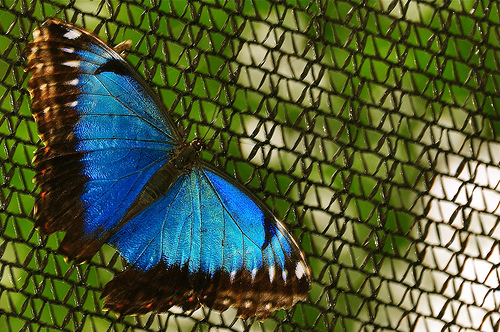 Intelligent Design
Intelligent Design
One Butterfly Inspires Multiple Technologies

Have you ever met a Morpho in metamorphosis? You should look closely at what hatches out.
The Morpho is a jewel among butterflies, with its gracefully contoured, iridescent blue wings flashing in the breeze. Familiar from the cover of Illustra’s film Metamorphosis, this species exhibits additional intelligent designs the film didn’t have time to discuss.
Their brilliant color comes not from pigments but from precisely aligned structures in the wing scales that play tricks with light, producing what physicists call "structural color." Certain colors are canceled out, and others reinforced, by the arrangement of "photonic crystals" that resemble tiny trees made of biomolecule chitin.
Engineers have already mimicked the iridescence by creating photonic crystals of their own. But there’s more. The structures on Morpho butterfly wings also absorb heat, repel water, and control the flow of vapors. The Morpho is a treasure house of design ideas for biomimetics projects, as research news from the University of Exeter reveals. From fabrics to cosmetics to sensors, all kinds of innovations are being inspired by this one genus of butterfly:
Now research by the University of Exeter, in collaboration with General Electric (GE) Global Research Centre, University at Albany and Air Force Research Laboratory, and funded by the US Defense Advanced Research Projects Agency (DARPA), has discovered that the physical structure and surface chemistry of the Morpho butterfly’s wings provides surprising properties that could offer a variety of applications ranging from photonic security tags to self cleaning surfaces and protective clothing and to industrial sensors. (Emphasis added.)
A paper in PNAS describes a "surface polarity gradient" the team found in the wing scales that provides "selective vapor response." This set the authors’ minds whizzing with possibilities: "This biological pattern design may be applied to numerous technological applications ranging from security tags to self-cleaning surfaces, gas separators, protective clothing, and sensors." This paper adds to the bio-inspired work by Radislav Potyrailo and his team at G.E. labs reported here last year ("G.E. Brings Life to Good Things").
Other labs are studying the Morpho butterfly carefully. At the National Institute of Advanced Industrial Science and Technology, Eijiro Miyako’s team has hybridized a rare species of Morpho with human technology, New Scientist reports. They coated the wing with carbon nanotubes that self-assembled onto the biological pattern, inspiring more possibilities:
But their creation isn’t just inspired by nature. It is a real hybrid of butterfly wings fused with nanocarbon that imitates traits found in nature but is also tough to reproduce through technology alone. It could potentially play a role in digital diagnosis of disease, power flexible microscopic photovoltaic cells or even help create soft wearable electronics.
Notice how the butterfly exhibits traits that humans find "tough to reproduce through technology alone." Doesn’t that suggest a superior designing intelligence made the butterfly? Miyako’s paper is published by ACS Nano (for summary, see here).
We don’t want to shortchange other butterflies. The "Green Hairstreak" butterfly, ranging from the UK to Siberia, has inspired another unique technology, according Swinburne University of Technology. Engineers in Australia and Germany created a miniature polarized beamsplitter from its wings, able to split, for the first time, circularly polarized light.
The design for this crystal was inspired by the Callophrys Rubi butterfly, also known as the Green Hairstreak. This butterfly has 3D nano-structures within its wings which give them their vibrant green colour. Other insects also have nano-structures that provide colour, but the Callophrys Rubi has one important difference.
"This butterfly’s wing contains an immense array of interconnected nano-scale coiled springs that form a unique optical material. We used this concept to develop our photonic crystal device," Swinburne PhD graduate, Dr Mark Turner, said.
With this invention, they can steer light in nano-photonic devices used in telecommunications. "It has the potential to become a useful component for developing integrated photonic circuits that play an important role in optical communications, imaging, computing and sensing."
All this from just two kinds of butterflies. With up to 20,000 species known, there should plenty to keep engineers busy into the future (to say nothing of biomimetics projects coming from the study of geckos, spider webs, oysters, lotus leaves, elephant trunks, Venus flytraps, and much more).
A researcher from University of Exeter summed up by saying:
By using design ideas from nature we are able to work towards the development of applications in a range of different technologies.
One may surmise that they wouldn’t work so enthusiastically if these "ideas from nature" were not, in fact, intelligently designed.
Image credit: Armando Maynez/Flickr.
